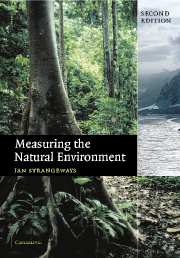Book contents
- Frontmatter
- Contents
- Acknowledgements
- 1 Basics
- 2 Radiation
- 3 Temperature
- 4 Humidity
- 5 Wind
- 6 Barometric pressure
- 7 Evaporation
- 8 Precipitation
- 9 Soil moisture and groundwater
- 10 Rivers and lakes
- 11 Data logging
- 12 Telemetry
- 13 Visibility
- 14 Clouds
- 15 Lightning
- 16 The upper atmosphere
- 17 The oceans
- 18 Cold regions
- 19 Remote sensing
- 20 Atmospheric composition
- 21 Forward look
- Appendix: abbreviations and acronyms
- Index
- References
19 - Remote sensing
Published online by Cambridge University Press: 05 July 2014
- Frontmatter
- Contents
- Acknowledgements
- 1 Basics
- 2 Radiation
- 3 Temperature
- 4 Humidity
- 5 Wind
- 6 Barometric pressure
- 7 Evaporation
- 8 Precipitation
- 9 Soil moisture and groundwater
- 10 Rivers and lakes
- 11 Data logging
- 12 Telemetry
- 13 Visibility
- 14 Clouds
- 15 Lightning
- 16 The upper atmosphere
- 17 The oceans
- 18 Cold regions
- 19 Remote sensing
- 20 Atmospheric composition
- 21 Forward look
- Appendix: abbreviations and acronyms
- Index
- References
Summary
… it seemed unto me no other than a huge Mathematicall Globe, leasurely turned before me, wherein successively, all the Countries of our earthly world within the compasse of 24 howres were represented to my sight.
Francis Godwin — Bishop of Hereford 1617—1633. The Man in the Moone, 1638
(Domingo Gonsales, flying towards the moon on a framework drawn by swans, looks back towards the Earth).This is but a brief review of a complex subject that is constantly developing. It is intended to give an overall impression rather than a detailed account. The aim is to outline the sensors used on spacecraft, what wavelengths are being measured and to investigate what variables can be sensed remotely and how this can be done. Putting remote sensing (RS) into context with ground-based measurements, the main topic of this book, is also an important consideration for this chapter. For those wanting more detail on any one topic, the web pages of NASA and EUMETSAT are invaluable. Start with the home pages (www.nasa.gov and www.eumetsat.de) and select the appropriate subject.
Satellite orbits
These have already been touched on in Chapter 12 on Telemetry, but some additional points are worth introducing here that are relevant to RS.
Atmospheric drag limits orbital height to 300 km or more. Satellites at altitudes of 500—2000 km are usually operated in nearly circular polar orbits (giving orbital times of 1—2 h), 880 km being typical for meteorological satellites. Because the Earth has a slightly greater diameter at the equator than through the poles, a small change occurs in the satellite’s orbital period, causing precession of the orbital plane. For a given height, an inclination from the purely north–south path can be calculated that causes the plane to precess one rotation per year. This results in the plane staying fixed relative to the Sun (as the Earth orbits the Sun) and so this is termed a Sun-synchronous orbit, the satellite passing over the equator at the same time at each pass through the year. Most remote sensing satellites are in this type of orbit.
- Type
- Chapter
- Information
- Measuring the Natural Environment , pp. 469 - 502Publisher: Cambridge University PressPrint publication year: 2003



